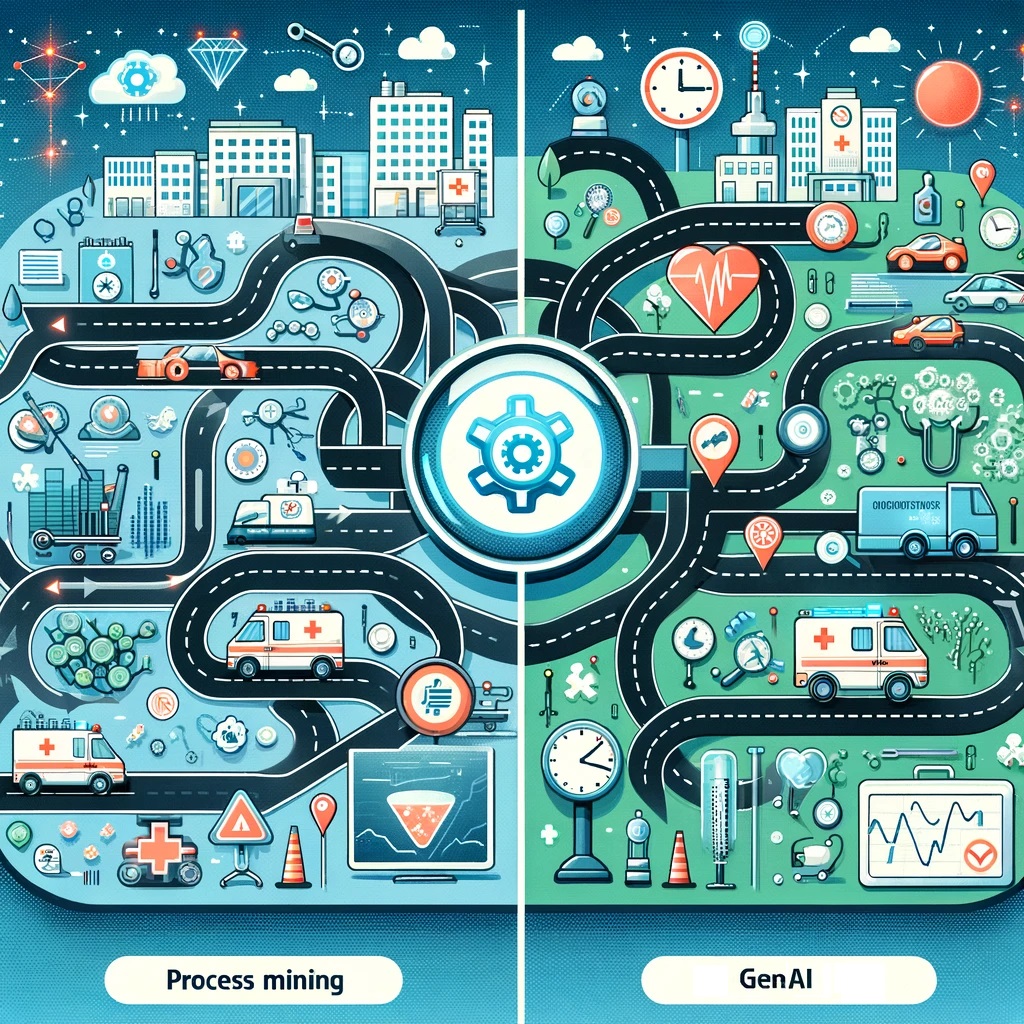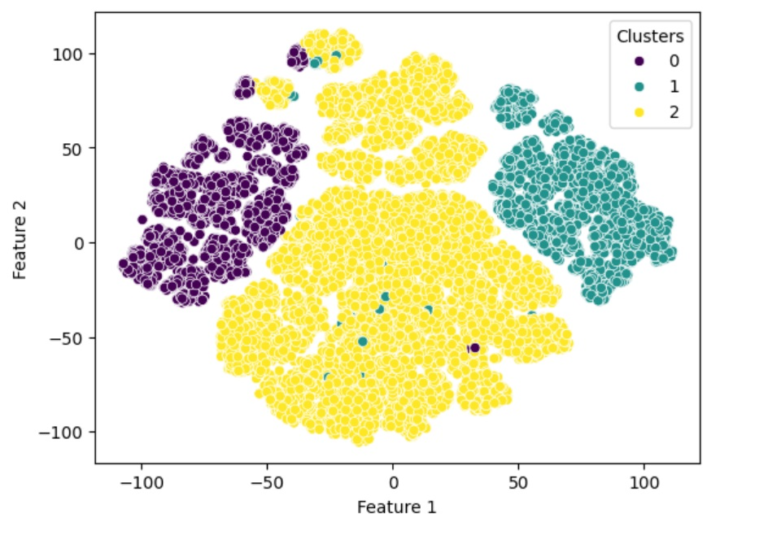
Uncovering the power of process mining with generative AI can constructively disrupt how we understand and optimize processes across various industries, including healthcare. We will explore this here with some easy-to-understand use cases from healthcare that we could relate to.
What is Process Mining?
Imagine figuring out the best way to get from home to work. You have a map, but it only shows where you start and where you need to end up. Process mining is like drawing your route, including every turn, stop, and detour. It uses data from your business processes (like transactions, activities, and checks) to show you what’s happening, not just what’s supposed to happen.
How Does Generative AI Fit In?
Now, bring generative AI into the mix. This type of artificial intelligence can create new content – like writing, images, or even new data patterns. When you combine generative AI with process mining, it’s like having an intelligent assistant that doesn’t just show you the route you took to work and suggests better routes, predicts traffic jams and finds shortcuts you never knew existed. It can look at the mess of roads, paths, and alleys (your business processes) and generate more apparent, more efficient ways to get where you’re going (optimize those processes).
Here are a few use cases where Process Mining and Generative AI could work very well together –
Streamlining Hospital Patient Flow
Patient wait time is highly unpredictable, especially in developing countries like India, where resources are still limited, but the volume is tremendously higher. I experienced this in India with my parents and others. Finding the right hospital and care is overwhelming in itself, and unpredictable waits make it more unpleasant for patients and their families, even after showing up on time for the appointment.
Streamlining hospital patient flow is crucial in settings where resources are limited, and patient volume is high. The patient journey through a hospital involves several critical steps—from admission, diagnosis, treatment, and finally discharge. Each step is a potential bottleneck, especially in under-resourced facilities facing high demand. Process mining and generative AI offer promising solutions to these challenges by optimizing patient flow and reducing wait times.
Process mining helps by creating a detailed map of the patient journey. This technology analyzes data from hospital information systems to track each process step, from check-in to discharge. It identifies where patients spend the most time waiting, which procedures create bottlenecks, and when and where resources (like medical staff and diagnostic equipment) are stretched thin. For example, it might uncover that most delays happen during peak hours in the diagnostic imaging department.
With the insights from process mining, generative AI can simulate different scenarios to find practical solutions. It could suggest reorganizing staff shifts to ensure more hands on deck during peak times or rearranging the order of diagnostic tests to prevent bottlenecks in imaging services. For instance, conducting specific blood tests while patients wait for imaging results could streamline the process, reducing wait times.
Moreover, generative AI can predict high-demand periods and suggest proactive measures, like scheduling additional staff or opening temporary testing centers. This approach not only smooths the patient journey but also makes it more predictable, greatly enhancing the overall efficiency of hospital operations in resource-limited settings.
Many clinics need help with scheduling appointments efficiently. Process mining can reveal patterns, such as peak times for specific treatments or common cancellations. Generative AI can generate new scheduling models that better match patient demand with available resources, reducing wait times and improving care.
Enhancing Medical Supply Chains – Especially the Last Mile
The last mile in any supply chain is usually very tricky and unpredictable. In many scenarios, last mile could take more than the time it took to get to the last mile. Healthcare providers rely on a complex supply chain for medical supplies. Enhancing the last mile of medical supply chains is crucial for healthcare providers to maintain high standards of care. This final step, the journey of supplies from local distribution centers to hospitals and clinics, is fraught with challenges such as traffic delays, incorrect deliveries, and unpredictable demand spikes. Process mining and generative AI offer innovative solutions to these challenges.
Process mining acts like a diagnostic tool in this use case, meticulously analyzing the journey of medical supplies through the last mile. It can pinpoint precisely where delays occur, whether it’s a particular area prone to traffic jams or a specific time of day when deliveries slow down. By mapping out the delivery routes and times, process mining reveals patterns and bottlenecks that might take time to be apparent.
Once the inefficiencies are known, generative AI becomes a problem solver. It can simulate various scenarios to find the most effective delivery strategies. For example, delivery schedules can be adjusted to avoid peak traffic times or proposed using different transportation modes faster for specific route segments. Generative AI can also forecast demand spikes for particular supplies, such as flu vaccines, and recommend stockpiling in nearby distribution centers in advance.
By combining these insights and suggestions, healthcare providers can achieve a smoother, more reliable last mile. This might mean deploying drones for urgent deliveries to bypass traffic entirely, using predictive analytics to pre-position supplies in anticipation of demand, or collaborating with alternative local suppliers for faster replenishment.
Enhancing the last mile in medical supply chains with process mining and generative AI transforms a traditionally unpredictable and inefficient process into a streamlined, data-driven operation. This ensures that hospitals and clinics receive their medical supplies on time and helps manage resources more effectively, ultimately contributing to better patient care and operational efficiency.
Personalizing Patient Care
In digital healthcare, personalized care plans are essential but hard to scale. Process mining can track how different patients move through the care system, identifying common pathways and outcomes – charting out the patient journey that’s based on a complex amalgamation of real-world evidence, administrative, and clinical data. Generative AI can use this information to create customized care plans for similar future patients, improving outcomes by learning from past successes and failures.
Let’s assume that you’re a doctor trying to create a unique care plan based on your health, habits, and needs. Now, think about doing this for hundreds or thousands of patients. It sounds overwhelming. This is where the magic of digital tools like process mining and generative AI comes in.
Process mining could examine patients’ journeys in the healthcare system – both from administrative and clinical perspective, understanding the steps they take, from check-ups to treatments, to-outcomes. It notices patterns, like which treatments work best for which types of patients or where patients tend to wait too long.
In this scenario, Generative AI would take all the clues gathered by process mining and develops new, tailor-made care plans for every patient. Suppose process mining noticed that patients with a particular condition do better with a specific treatment. In that case, generative AI remembers and applies this knowledge when creating a new care plan for a patient with the same condition.
For example, if John and Emily both have diabetes but Emily is also pregnant, their care needs differ. Process mining spots the different paths they’ve taken in their care, and generative AI uses this info to suggest a special diet and exercise plan for Emily while advising different medication adjustments for John.
Simply put, process mining and generative AI work together to ensure that every patient gets a care plan that’s just right for them, based on real data and previous successes. It’s akin to a healthcare system that learns from every patient to provide better, more personal care for the next one, ensuring everyone gets what they need to feel their best.
These use cases showcase how combining process mining with generative AI can offer powerful insights and suggestions for improvement across various processes. It’s like having a highly skilled analyst and planner working tirelessly to make your operations as efficient and effective as possible. The potential applications in digital healthcare and beyond are vast and exciting, from streamlining patient flow in hospitals to personalizing care plans.
The power of process mining with generative AI is more than just technology. It’s about finding innovative, faster, and more patient-centered ways to manage and improve healthcare. By embracing these tools, organizations can navigate the complexities of modern healthcare, making informed decisions that benefit both patients and providers.












